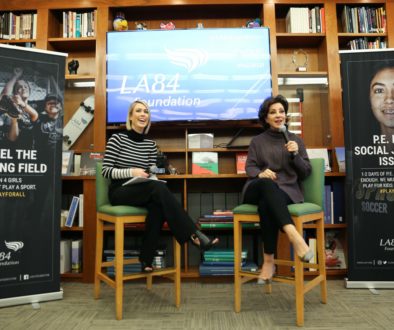SL Interview: “Off the Rez” Director Jonathan Hock
Director-producer Jonathan Hock has made a career out of creating must-watch documentary films. “Through the Fire” (2005) told the story of high-school basketball phenom Sebastian Telfair as he decided between attending college and jumping to the NBA. “The Streak” (2008) was about the Brandon High School wrestling program in Florida, which began its 2007-08 season with a 34-year, 439-match winning streak. In “The Lost Son of Havana” (2009), Hock followed former pitching great Luis Tiant on his return to his homeland of Cuba. Last year’s “The Best That Never Was” profiled former football star Marcus Dupree for ESPN’s “30 for 30” series.
His latest film, “Off the Rez,” is equally compelling. Hock profiles Shoni Schimmel, a Native American high school basketball player from the Umatilla Indian Reservation in Oregon. Schimmel is a star in the making. High school scouts raved about her – “the skills and court instinct to make everyone in the gym pay attention each time she touches the ball. She’s uncanny both with her scoring and passing ability and it’s almost always with some flair. The range on her perimeter shot is pretty much anything inside half court” – but the obstacles that she and other promising Native American athletes face are unique: a persistent cycle of failure highlighted by teen pregnancy, alcoholism and diminished expectations. One such “victim” is Shoni’s own mother, Ceci Moses, a fiery woman who was sidetracked from pursuing an athletic career because of pregnancy.
The film follows Schimmel as she leaves behind the security blanket of the reservation for her junior and senior years at Franklin High School in Portland. Her coach is none other than her mother, Ceci, who is determined that the confines of the reservation will not stymie her daughter’s collegiate hoop dreams.
Executive produced by Kelly Ripa and Mark Consuelos, “Off the Rez” premiered at the 2011 Tribeca Film Festival in April and recently aired on the TLC network.
SportsLetter spoke to Jonathan Hock from his offices in New York.
— David Davis
SportsLetter: You started your career with NFL Films. What did you learn about storytelling from NFL Films?
Jonathan Hock: I learned probably the most important lesson I ever learned from [NFL Films president] Steve Sabol, who was my mentor: don’t be afraid to fall in love with your story. Nobody knows something better than the person who loves it. And, when you get close enough to your story and to your characters, that’s where you find a very special kind of truth.
I think people take the idea of objectivity and turn it into dispassion. They’re not the same. You can be objective about something and passionate about it. To me, true objectivity is going in with an open mind and discovering where the story is, not going in with a preordained notion of what the story is based on your ideology or your politics. Once you find the point of the story that connects to your heart or your soul as a storyteller, that’s when you start digging in to find the magic.
SL: Why did you decide to transition from NFL Films to making sports documentaries?
JH: I loved my job at NFL Films. I loved the people I was working with. I felt I could stay there forever and be perfectly happy, but I wouldn’t see much of the world. So, I stopped working for NFL Films and came home and started a film workshop program for at-risk youth in the public high school system in New York City [“The Reel People Film Project”]. I had an idea to bring filmmaking to them as a means of self-expression and, hopefully, self-esteem because it had done so much for me as a person. NFL Films was very supportive and gave me camera equipment, and Kodak donated film. I went out with a bunch of 15-year-olds and coached them as they made short narrative movies all around New York City. One of my original students, Alistair Christopher, was 15 when he picked up a camera. It was like he was born with it in his hands, he had such great vision and talent. After the program ended and I started working on films independently, he started hanging around the office and then taking a camera and getting second unit stuff and then coming out on main shoots. Eventually, I had to demote myself to “B” camera and promote him to “A” because he was so much better than I was. He’s my director of photography to this day.
I was brought out of retirement, so to speak, to work on the “Michael Jordan to the Max” film. I got the bug again after writing and editing that film. One thing led to another, and eventually I was hired by HBO to do a short film that would air on the “Bob Costas Show” the night that LeBron James was being drafted to the NBA. They had said I could do anything I wanted. I said, “Well, I want to go out to Coney Island and do something with the kid who a lot of people are going to be talking about a year from now. He’s going to be a senior in high school, and his name is Sebastian Telfair.”
So, I did that as a short film for HBO. There was such a great story unfolding around Sebastian that, afterwards, I talked with him and his family and his coach and said, “How would you like to do a film together?” That became my first full-length independently produced documentary feature, “Through the Fire.”
SL: With “Off the Rez,” how did you first come to learn about Shoni Schimmel?
JH: Nelson Hernandez, who’s one of the producers on the film, had called me back in 2006, when he was running a Native American youth organization. He was organizing a national gathering at the Red Lake Reservation in Minnesota, where there had been a massacre [in 2005]. He asked me if they could show “Through the Fire” because basketball is hugely important culturally on the reservation, which I didn’t know at the time. He felt that the film, being about a family that holds it together despite violence around them and despite economic hardship, would be an inspiring story for these young Native Americans who were gathering to renew each other’s strength.
They showed the film, and Nelson and I stayed in touch. Two years after that, he called me and said, “I’ve got your next Sebastian Telfair.” I said, “Who is he?” He said, “It’s a she. Her name is Shoni Schimmel, she’s on the Umatilla Reservation in Oregon. They’re calling her ‘Pistol Pete in a ponytail.'” I saw her highlights on YouTube, and she was amazing, and then I went out to meet the family. That was the day they were moving to Portland. I had dinner with them and spoke to Shoni’s mom, Ceci. She told me why they were leaving the reservation and how there’s a cycle of despair and hopelessness and unfulfilled talent on the reservation. She felt that she was as much to blame as anyone else because she knew that she was a very talented person and yet she let the circumstances of reservation life – lack of resources, racism from the outside, teen pregnancy in her case – get in the way of her destiny. Now, she had an opportunity to become a high-school basketball coach in Portland, and she needed to show her kids that they could make it off the rez. She needed to show Shoni that your destiny is as big as you believe it can be, not as small as the rez will tell you it can be. I said, “Wow, this is a story.”
SL: What was your reaction seeing Shoni play for the first time?
JH: It was really exciting. I didn’t realize that girls’ high school basketball could be played with such toughness, such flair, skill, drama, intensity. And, that includes the coach. I didn’t realize that when I went to do a girls’ high school basketball story, the coach would make Bob Knight look like a choirboy.
SL: How would you describe the popularity of basketball on the Native American reservations?
JH: Hoops on the reservation is the same as it is in the inner-city ghettos all around the country. It’s the same thing. And the reservation, in many ways, is the same thing as the ghetto. It’s just not in the middle of the city. It’s far enough away for most of us to forget about, for most of us to ignore and not have to face the unbelievable injustice that is taking place there day after day after day. With basketball, for the same reasons it’s so big in the ‘hood, on the rez you don’t need much. You get an iron ring and a ball and you can go. A milk crate and a ball, and you can hoop. There’s no economic barrier to play and play well. Now you have a thing that everybody can do. Now you have a way to prove yourself in a world that is not giving you many ways to prove your worth, as an individual or as a group or as a tribe.
The Native American basketball tournaments, where they go to the other reservations and play against other teams, it’s intense. It’s very, very important to them. One of the characters in the film describes it as war. Justin Quaempts, a super-talented Native athlete who pitched at Oklahoma State, helped to open our eyes to life on the reservation and how important basketball is. He said, “We get to be warriors again. That was taken from us.”
SL: In the film, you talk about Shoni being so important to so many different groups – her own family, Native Americans, female athletes. How was she able to handle that pressure? Did you ever see her lose composure during the filming?
JH: Shoni is such a gifted player, it’s like she feels the game in her soul. She’s one of these people, like Larry Bird, the game is just in her soul. When she’s playing, there’s nothing else that’s going on other than the basketball. When she’s playing, I don’t think that the pressure weighs on her.
I do think, however, that during the shooting of our film the idea of leaving her people to go and play somewhere else was a tremendous source of pressure for her. As one of the people on her reservation says, “This whole history of not making it is riding on Shoni’s shoulders. Everyone’s watching her.” The fact that everybody was counting on her was very, very difficult, and I think it made it difficult for Shoni to move on to the next step.
SL: Do you think that’s why she delayed until the last moment to announce which college she was going to?
JH: I think that was part of it. I think the other part of it was that it was just impossible for her to grasp not being with her family. I think any reality of going away to school meant she wouldn’t be with her family, and that was not in her frame of reference. She didn’t know how to do that.
SL: During the course of filming, did you hear any racist taunts directed at Shoni or see any prejudice against her as a Native American?
JH: I didn’t hear any taunts in the gym. Typically, I was shooting the coach, Shoni’s mom, and we’ve got her mic-ed up. I had my headphones on and was listening to her. Apparently, at a couple of games that we were at, there were some things shouted at them. I didn’t hear them with my own ears. I certainly saw the letter that told them to go back to the f-ing reservation. That sort of stuff creeps in. There was a quote in a story about Shoni going to play for Franklin [High School in Portland] in the local newspaper, where the writer quotes an opposing coach as saying, “Franklin sold their soul to the devil.” At best, it’s an incredibly insensitive comment. At worst, and what I think it is, it embodies the racist idea that these people from the reservation are somehow less than Christian, that they are savages or pagans or whatever. The irony of it is, Christianity is very important to Shoni and her family. Even if it weren’t, the idea that you would go to print with a term that is so loaded with a “holy war against the savages” kind of thing shows you what they have to deal with on a day-to-day basis.
SL: Shoni’s father, Rick, appears throughout the documentary, but much of the film revolves around the relationship between Ceci and Shoni. How would you describe the relationship between Shoni and Ceci? Where’s the line between mother-daughter and coach-player?
JH: Ceci defines the line as, when we go to the games it’s a professional relationship. I’m the coach, and you’re the player. If you want to take it out of that realm, then I become the mother again, and it’s not pretty. That’s a pretty good definition.
SL: Ceci used a lot of profanity when she was coaching Shoni and the other kids on the team. Were you surprised about that and would you want her coaching your daughter?
JH: I work really hard to make a better life for my kids. Ceci has to fight to make a better life for her kids. It’s a very big difference, a very important difference. Fortunately, thanks to my immigrant grandparents and my first-generation parents, I was put in a place where I didn’t have to fight. I had to work hard – I still do – but I didn’t have to fight. So, I can’t judge what having to fight everyday does to your vocabulary. I can tell you that the other players on the team, not just her daughters, love her. They loved playing for her. They loved the respect they got from her. They loved what she allowed them to be and what she believed in them to be. When she says to a player, “You go out and play like an Indian,” she means, “Be proud, be strong, don’t back down, don’t be afraid even if the odds are against you, fight to the end.” That’s a great message for a girl to get. That’s a great message for a girl who wants to be an athlete, who wants to achieve, who wants to prove something to herself that she can’t prove in math class. If there are a few f-bombs that come along with that, I’m not appalled. It’s not my style, but in those terms I understand it.
SL: Did you ever feel that Ceci was putting too much pressure on Shoni?
JH: Not willingly, but clearly Ceci carries a lot of anger from her own life and her people’s history. That anger is there, it’s close at hand. When, as a parent, you carry a sense of injustice done to you and then your daughter has the skills to achieve what you might have been able to but didn’t, that puts a lot of pressure on a kid. Ceci was certainly not like a stage mother, where she’s saying to Shoni, “You have to get this many points in the game and everybody’s counting on you,” but in this case she didn’t have to say anything to give Shoni all the baggage. It just happened, even if it wasn’t Ceci’s intent.
SL: Did you feel that she was trying to live her life through Shoni?
JH: Again, I don’t think it’s conscious. But when your belief is, “I could have been but weren’t,” and then your message to your daughter is, “You can,” the unspoken linking line there is, “and you have to, because I didn’t.” In other words, if my life is going to have a purpose, you’re going to make it. Now, I think Ceci tries hard to not put that on her daughter. But you can’t avoid it. Your family is your family, and your family’s history is its history, and you can’t run from it.
SL: Why do you think it’s been so difficult historically for Native American athletes from the reservation to make it in mainstream D-I college programs?
JH: I think it’s not just sports — it’s equally difficult for them to make it in a job in an office in the city. The outside world is extremely foreign to them, and the gulf between reservation life and the outside world psychologically is enormous. The message they receive off the rez is, you are not wanted here. You don’t belong here. The reason you live where you live is because we put you there. It’s not like the reservation is a town that cropped up somewhere out in the middle of nowhere. These were people who lived elsewhere, who moved around in the course of their lives and their livelihoods, and then were told, you’re not allowed to do that anymore. You can’t do what you do. You have to live here, and you can’t move. So, they don’t even see that their talent can resonate in the outside world and that there will be people who will embrace them off the reservation.
SL: How about with Native American female athletes – is it more difficult for them to make it off the reservation?
JH: I’m told it is, but it’s hard for me to know because I have no basis for comparison. I didn’t watch a young man from the reservation. I only know the experience through Shoni and her family. But I’m told it’s particularly difficult for Native American women, as it is for women anywhere.
SL: At the end of the film, we learn that Shoni had an outstanding freshman season at the University of Louisville. What do you see her future in basketball?
JH: To me, Shoni is one part Pete Maravich and one part Jackie Robinson. She brings a flair to the game, combined with greatness, that is going to help unleash a wave of creativity among female basketball players, much as it was unleashed in men’s basketball forty years ago, when Maravich and Earl Monroe and Julius Erving and other people liberated the game from its conservative masters. I think you’re going to see the same thing in women’s basketball, and Shoni’s going to be a part of it.
SL: Shoni’s younger sister, Jude, plays a significant role on the team and in the film. How is she doing?
JH: She’s following Shoni to Louisville. She’s an incredible defender, incredibly quick. She’s always stealing the ball, always getting in the passing lane, always disrupting. I think she scored more as a senior than Shoni did as a senior.
SL: And how is Ceci doing?
JH: Ceci is still coaching at Franklin in Portland. This will be her third season, but her first without having either Shoni or Jude on the team. So, it’ll be interesting to watch her.
SL: What most surprised you when you were filming “Off the Rez”?
JH: The intensity of the basketball, the intensity of the competition, the intensity of Ceci, Shoni and Jude on the court. I didn’t realize girls’ high school sports could be like that.
SL: How was this experience different from shooting “Through the Fire,” about Sebastian Telfair?
JH: It was more similar than different. You go into a place that’s foreign. I’d certainly spent time in the ‘hood before, but not so much and not so constantly. I was in the role of interloper, a member of the establishment who is not to be trusted by the people who live there and who have gotten the short end from the establishment all their lives. There was a huge hurdle of trust to overcome and a way of being, a sense of personal space, all kinds of interpersonal things that don’t easily translate from one sub-culture to another. Fortunately, at my side I had Alistair Christopher, the cameraman, who is a genius at human relations. He understands people better than anyone I ever met. He knows how to be in a room with people. He’s the secret weapon.
SL: What other differences did you observe between Sebastian and Shoni?
JH: Sebastian certainly has a swagger that Shoni doesn’t, at least off the court. I think that’s just a personality difference. Sebastian is much more outgoing. He loves the spotlight. Shoni didn’t really need us around.
SL: With what you’ve seen in making these two documentaries about high school basketball, what’s the best part of youth sports at the elite level and what’s the worst?
JH: I think the worst things are easier to talk about than the best parts because there are so many great things about youth sports. The worst part is the pressure. There’s also the unrealistic expectation, even among the great ones, that this is your ticket to total happiness, that if you make it your life will change and everything will be okay. I think Sebastian got everything he wanted and still everything wasn’t okay afterwards. I think Shoni is getting what she’s hoping for and continuing to work hard to get what she wants, but it doesn’t mean that life is going to be perfect. At a certain high level of play, there’s an unreality to your world view as a teenager, where you think that if you make it, it’s an all-or-nothing game. And, it isn’t. Even if you happen to make it, which is very rare, it’s just what you do. It’s not who you are and it’s not who you love. None of those things that make you really happy in life are guaranteed just because you’re an NBA lottery pick or you get a college scholarship.
The great thing about youth sports is that it fosters hard work. You have to go out and earn it, and the goals that these players maintain are worth aspiring to and worth making the sacrifices that they have to make in their lives. A lot of good comes from that experience, that you have to work for what you get. Those are great things to take on in life.
SL: You also directed “The Best That Never Was” about football phenom Marcus Dupree for ESPN’s “30 for 30” series. What lesson do you take from his experience?
JH: He’s a guy who got a lot of bad guidance. He was mishandled and completely misunderstood. He came from another place, Philadelphia, Mississippi, that was almost as foreign as the Indian reservation. It had completely walled itself off from the world. He had no idea how to deal with the world, and the world had no idea how to deal with him. He was so sensitive and so quiet that no one saw the hard work he had done to make himself great. Somehow, all these “smart” adults felt that he had been anointed from above to be a running back, and they treated him like he hadn’t worked for it. That was hard for him to deal with, and he retreated from it for a while.
SL: In making two documentary films about high school basketball players, do you feel that they’re inevitably going to be compared to “Hoop Dreams”?
JH: To me, “Hoop Dreams” is not just a sports film. It’s not just a basketball film. It’s an incredible landmark film, and everybody should watch it and learn from it. But it’s told from the first-person perspective of the filmmaker – [director] Steve James quite literally inserts himself as the narrator halfway through the film. That’s not what I do, not that there’s anything wrong with that. But I put the point of view of my films into the shoes of the characters. I’m taking the audience on a journey in the shoes of Sebastian Telfair and his mother and his brothers and Shoni Schimmel and her mother and her father and her grandparents. The same applies with Marcus Dupree and Luis Tiant [in “Lost Son of Havana”]. I’m not a character in these, so they’re a very different kind of film.
There’s a truth that exists for these characters, for Sebastian Telfair and Shoni Schimmel, and it’s very hard to find sometimes. You work really, really hard shooting, and you work really, really hard in the cutting room to find it. That’s my challenge. Every film is its own challenge. Certainly, when you do a “30 for 30” film, and there are 29 other incredible filmmakers contributing to the series, you want your film to stand up among the best of those. But you can’t measure yourself by another person’s work that was done in pursuit of another goal. You’ve got your own goals, and you just try to get it as close to that as you can each time.
SL: With ESPN’s “30 for 30” series and all the films on HBO, what do you see as the future of sports documentaries?
JH: I think “30 for 30” proved that there’s an audience, and a passionate audience, for good stories well told. For a while, I think ESPN felt that people wanted only live events and news. But people want a great story. They want the narrative, not just the game. They want to feel that it means something. We used to get that a century ago from Grantland Rice and those sportswriters who were the first ones to turn Jim Thorpe or Babe Ruth or Vince Lombardi or any legendary figure into a narrative that spoke to something greater, even if it wasn’t really them. In today’s world, despite the cynicism and how jaded people are, sports fans still hunger for that narrative, that meaning beyond the final score, and that’s a great thing for those of us who like telling those stories.
SL: What is next for you, both for “Off the Rez” and upcoming film projects?
JH: “Off the Rez” just aired on TLC. We’re waiting to hear what they’re going to do with it next. Our Facebook page has been going bonkers with people wanting the DVD and wanting to download it, and so we’re going to try and get that ready for them as soon as we can.
My next sports project is about Chris Herren, who was the subject of a great book called “Fall River Dreams” [written by Bill Reynolds], which everybody should read. Chris was an extraordinary player, one of the great schoolboy basketball players in Massachusetts history. He made it to the NBA and became addicted to drugs and lost it all. He’s now gotten clean and found contentment without the drugs and without basketball. Talk about a story of pressure and how it can wreck a person’s life. That’ll be on in November on ESPN.




